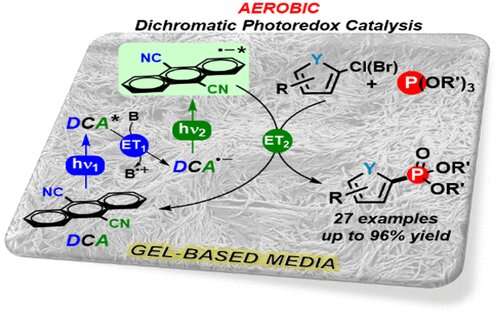Mimicking nature to obtain more efficient, cleaner, and cheaper chemical compounds

A team from the Universitat Politècnica de València (UPV), in collaboration with the University of La Laguna (ULL), has developed a new methodology that, by imitating the photosynthesis of plants, allows to obtain more efficient, clean and economical chemical compounds used in the food, pharmaceutical or oil industry, among many other sectors. This work, published in the journal ACS—Applied Materials & Interfaces, represents a "key contribution and opens an innovative path" in the field of organic synthesis.
"During photosynthesis, plants and other organisms convert solar-to-chemical energy. In this sense, nature has smartly normalized these photochemical processes by using visible light in aerobic and confined microenvironments. In this work, we have achieved to mimic this natural process following the Z-scheme mechanism of photosynthesis and applied it to the field of organic synthesis. To that end, we have developed a photocatalytic strategy which includes visible light, aerobic conditions and the use of supramolecular gels as confined medium, playing the role as membranes, mirroring a similar scenario than nature and pave the way to a more efficient, fast, cheap and green production of organic chemical compounds," says Raúl Pérez-Ruiz, researcher at the UPV Department of Chemistry, hired with funds from the Program to support talented researchers (GenT-CIDEGENT Plan) of the Generalitat Valenciana.
The use of supramolecular gels as reaction medium allows not only to carry out photochemical transformations under aerobic conditions, but also to accelerate the reaction and, ultimately, the synthesis of the material. "The gels act as photonanoreactors, decreasing drastically the required time for the synthesis from 24 hours to four hours, with the subsequent energy and economic savings," explains Raúl Pérez-Ruiz.
To validate this new methodology, the UPV team has worked on the synthesis of phosphonates that are widely used in various scientific fields such as water treatment, desalination systems, the textile industry and even in the medical and materials fields.
"We have focused on the synthesis of five-membered heteroarene phosphonates. Nowadays, employment of conventional methods to obtain these compounds somehow require mostly complex conditions. In this study, we have developed an alternative procedure under very mild conditions, using a commercial organic photocatalyst and imitating the microenvironment of cells in order to perform this type of synthesis. To the best of our knowledge, this represents a new strategy to obtain these compounds, permitting us to synthesize new products with high performance and in a much greener way," says Raúl Pérez-Ruiz.
More information: Jorge C. Herrera-Luna et al, Highly Efficient Production of Heteroarene Phosphonates by Dichromatic Photoredox Catalysis, ACS Applied Materials & Interfaces (2021). DOI: 10.1021/acsami.1c14497
Journal information: ACS Applied Materials and Interfaces
Provided by Universitat Politècnica de València





















